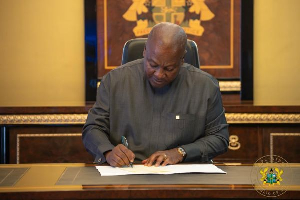Opinions of Saturday, 20 February 2021
Columnist: Kofi Adu
Is the Krontihene of a town in his caretaker role a regent?
In the Akan land, the Krontihene is an important subchief of a town, second only to the Ohene or Chief. The Krontihene and other subchiefs such as the Gyasehene, Akwamuhene, Nifahene and Benkumhene, form the Ohene’s cabinet or Atrankonya. The Krontihene is the senior of the Atrankonya and assists the Ohene in the day to day administration of the town. When the Ohene passes away or is not available, part of the Krontihene duties is to act as caretaker of the town until a successor to the Ohene is elected and installed.
As indicated above, the Krontihene acts as an administrative assistant to the Ohene and the Ohene may delegate certain traditional administrative duties he deems fit to him. This may include functions such as pouring libation to the ancestors, settling disputes in the traditional court or leading a traditional delegation to another town.
However, when the Ohene is permanently unavailable, the caretaker function of the Krontihene kicks in. In the Akan land, the Krontihene is additionally referred to as the ohwekyire i.e. the caretaker of the town. Accordingly, the Krontihene may continue the administrative duties of taking care of the town during this interim period. At the same time, the Royal family and the subchiefs headed by Krontihene work together to find a new Ohene.
Generally, the Ohene is basically the chief executive officer of the town, the superior head of the external Stool lands and the de-facto head of the Royal family. The Ohene may also hold a cabinet position in the Oman (Traditional State or Paramountcy) to which the town belongs. All these give the Ohene a wide range of responsibilities and power. However, the Ohene does not have absolute power, for there are inbuilt checks and balances to ensure that the Ohene is accountable. Particularly, the position and counsel of all of the following are very essential to put the Ohene in check - Omanhene and Divisional Ahenfo, the Atrankonya, the Ohema (Queenmother) and the Abusuapayin (Head) of the Royal family.
Let us examine certain specific functions of the Ohene. As CEO of the town, he may create new subchief stools and receive nsuae (oaths) from stool occupants. He may also sell lands to developers. As the superior head of the external Stool lands, he may select their Odikro or Headsmen and receive nsuae from them. As the de-facto head of the Royal family, he makes important decisions in conjunction with the family heads. This may involve family property and Stools. And, if the Ohema passes away, he organizes the funeral and selects a new Ohema from the Royal family. Finally, as a member of the Omanhene’s cabinet, he sits in Omanhene’s court and performs duties assigned by the Omanhene.
Now, let us consider the situation where the Krontihene steps into the caretaker role when the Ohene is permanently absent. Which of the varied functions of the Ohene can he perform and which he cannot perform as caretaker?
Traditionally, the ohwekyire Krontihene may continue with the purely administrative functions such as deciding on day to day affairs of the town, sitting in state at Akan festivals like Adae, or settling disputes. Most importantly though, his role in this interim period is to work together with his team of Atrankonya and the Royal family to find a new Ohene as soon as possible. Indeed, the Krontihene functions ends at the purely administrative tasks and he has no business venturing into other executive functions of the Ohene. Specifically, as he is not a member of the Royal family, it is not the duty of the ohwekyire Krontihene to-
· Create or install Ohema, Subchiefs, Odikro or Headman
· Receive nsuae from above officials
· Take up the Ohene’s role at Omanhene’s court
· Sell Stool lands or property
· Make important executive decisions alone
· Pressure the Royal family to select or not select a particular candidate for Ohene
· Take custody of the Ahenfie (Palace), Stool Room, Estate of the late Ohene or Property of the Royal family
· Make Decisions for the Royal family regarding the Ahenfie, Stool Room, Estate of the late Ohene or Property of the Royal family, Funeral of Ohene or Ohema, etc
In other words, issues affecting the Royal family, Stools, Stool lands and property, etc are best handled by Ohema and Abusuapyin of the Royal family in the absence of the Ohene. Also, it is best practice to leave the creation of subchiefs and other executive functions of the Ohene pending, for the new Ohene to perform. If there is urgent need for an executive decision on an important matter, the Krontihene must consult with the Atrankonya and the Paramountcy. Indeed, that is why it is so imperative that a new Ohene is installed as soon as possible for full and effective administration and well-being of the town.
Unfortunately, the Krotihene finds himself in a serious conflict of interest situation where he is tempted to usurp some of the functions of the Ohene for his benefit. Notable ones are selling lands for personal benefit and pressuring the Royal family for his choice of Ohene candidate. He may also show no interest in a speedy process to install a new Ohene and intentionally create a stalemate which may last for many years. During this time, he may call himself a Regent, sideline officials and wield unchecked power which disrupts the traditional checks and balances.
It is worth noting that the English term “Regent,” is often used instead of a more appropriate Akan term. Is the ohwekyire Krontihene a regent? Being an English word, regent is defined by the Oxford Lexico Online Dictionary as-
“A person appointed to administer a state because the monarch is a minor or is absent or incapacitated”
Keywords here are that the person is “appointed” to “administer” a state (or town) in the absence of the monarch. Clearly, the Krontihene has not been appointed to administer the town in the absence of the Ohene. The ohwekyire function of the Krontihene is one of his normal functions and as such, Akan ancestors saw no need to create a separate Akan title for him other than the descriptive term ohwekyire. Therefore, the use of the Regent title by Krontihene in his caretaker role is wrongful and unknown in Akanland.
Nevertheless, there is an actual Akan concept of Regency which is similar to the English one as defined above. In this case, a person who is normally not an heir to the throne may be appointed as Ohene of a town in the interim. The appointing authority may be a superior Ohene, Omanhene or the Royal family and the Atrankonya. Such appointment may come with conditions under which the regent or Ohene may step down. For example, if the Regency was created because the heir was a minor, the Ohene must abdicate once the minor is ready to ascend the throne.
In today’s Ghana, the intransigence of many Krontihenes, motivated by greed and aided by false equivalences to foreign concepts have created enormous obstacles to peaceful transfer of traditional power. A whole lot of Chieftaincy disputes plying our courts were instigated by these Krontihenes who see their chance to cash-in on the demise of the Ohene.
Therefore, it is now time for Government, the House of Chiefs and Traditional authority to step in to streamline the various processes and functions of traditional office in accordance with the customs and traditions of the traditional areas. This will help to reduce conflict and disputes during traditional transfer of power, which take away resources from much-needed development. And, it is also time for defaulting Krontihenes, and others behaving as such, to be identified and brought to order.













